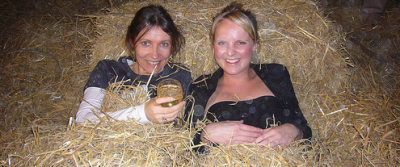
One of the dangers of exploring the nuclear energy option in the Middle East is radiation sickness and the risks it poses to power plant workers.
Of course we are all too aware of the risks of explosions like in Chernobyl too.
Radiation sickness, which by many is considered to be even more devastating than a possible nuclear bomb explosion itself, may be on the way to being greatly alleviated by the efforts of researchers such as Professor Andrei Gudkov, a chief staff member at the Roswell Park Cancer Institute in New York as well as being a researcher at Cleveland Bio-Labs; a branch of the Cleveland Medical Institute, in the USA.
In a special, exclusive article in the July 17 weekend edition of the Yediot Ahronot newspaper, and available on-line in English on Ynetnews.com, Prof. Gudkov, who received a PHD in molecular biology from Moscow University, came up with the idea of developing a protein based “vaccine” against the effects of radiation against radiation. It came to him while working on a medication that would enable cancer patients who undergo radiation therapy to withstand being exposed to radiation without suffering the usual harsh side affects – and with less damage to healthy, non-cancerous tissue.
Taking this research scope in mind, Gudkov, along with research associates such as Dr. Elena Feinstein (now working in Israel at the Weizmann Institute) came up with the idea to expand on this idea and come up with a serum that would protect thousands – perhaps millions of people from the lethal doses of radiation that are the result of a nuclear bomb explosion, a so-called “dirty bomb” attack by terrorists; or a nuclear reactor accident, such as the one that happened in the Ukraine in October, 1986, and is known today as the “Chernobyl Disaster“.
The theory as to why intense doses of radiation can kill so many people in a relatively short period of time, is the result of studies made on the victims of the two nuclear bomb attacks which occurred in Hiroshima and Nagasaki Japan in August, 1945. As well as following the Chernobyl incident in which hundreds of people were killed or severely injured by radiation following a melt-down of a nuclear reactor, which caused a radiation “cloud” to spread over a vast area, with traces of the resulting radiation being received as far away as Great Britain.
The scope of Prof. Gudkov’s research could have very positive implications for the Middle East, not only in light the possible threat from countries like Iran, or from nuclear terrorism, but for other reasons as well.
In a recent article written we wrote about Jordan’s proposed nuclear plans to build a series of nuclear power stations, and it was pointed out that the idea is being opposed by a number of prominent environmentalists in Jordan, most likely due to possible dangers from “nuclear accidents” such as the Chernobyl reactor melt-down in 1986.
In a comment made on my article by “a concerned Jordanian journalist” (read through the above link to the comments below) it was pointed out to us that the article appeared to be a bit misleading , even though the information in the article was culled from credible sources, including CNN and their international science and technology program.
What was also pointed out by the Jordanian “journalist” was that the proposed site of the first reactor is the southern Jordanian city of Aqaba, and not the eastern desert sector, which would be the most logical (and safest) area for such a plant. No doubt, the residents of the Israeli city of Eilat, just west of Aqaba, as well as in the rest of Israel, will be a bit unsettled if this is true — as Eilat is one of Israel’s biggest tourism locations for both local and foreign visitors. A nuclear reactor nearby and close to the pristine coral reefs in the Red Sea?
Whether exposure from lethal doses of radiation comes from a nuclear bomb or from a nuclear accident, from an environmental standpoint, nuclear energy has the greatest potential to become an ecological and environmental nightmare; as shown in the examples of the “A-bomb” blasts over Japan in 1945, and the Chernobyl disaster.
The reason people die so quickly from exposure to lethal doses of radiation is that the radioactive particles pass through the body, causing body cells to literally “shut down” or “self-destruct”, resulting in the eventual end of life itself; usually in as little as 7 to 14 days following initial exposure, depending on how close a person is to the source of the radiation itself.
In the new discovery Prof. Gudkov and his associates discovered that a protein substance, derived from bacteria such as salmonella bacteria (the same bacteria that causes food poisoning in larger amounts) protects cell tissue from breaking down or “self-destructing” when exposed to radiation. In tests conducted on both mice and monkeys, it was found that both groups injected with the protein fortification substance nearly always survived following radiation exposure, compared with the “control group” which was not protected; resulting in more than 70% dying, and the ones surviving being affected by varying degrees of radiation sickness symptoms.
The resulting serum has yet to be tested on humans; which means that it has not been approved as a “vaccine” by major government health authorities, including the US Food and Drug Administration (FDA).
Israel is already interested in obtaining the serum, even if not yet approved for human use. Naturally, such a serum would not protect people from the physical damage caused by an exploding nuclear device, which if only the strength of 100 kilotons (8 times the strength of the bomb dropped on Hiroshima), would destroy virtually everything within a 3 km mile radius of “ground zero” and up to 70% of everything within a distance of 30 km, depending on how close one would be to the initial bomb blast.
But even in the case of the Hiroshima and Nagasaki blasts, thousands would have been saved had they been protected by Prof. Gudkov’s serum. In the event of a “dirty bomb” attack, when very little physical damage would actually occur, the serum would save thousands of people from either death or severe injury from radiation exposure. This is also true in the event of another Chernobyl type of nuclear plant accident, including people developing various types of cancer afterwards.
It is still not known how long a person would need to take this serum following a nuclear accident or attack, and in what doses to obtain adequate protection, especially since some forms of radiation continue to be present in the affected area for years following the incident; as in the case the bomb blasts in Japan and the nuclear accident in Chernobyl.
In any event, the protein based serum if used in time, might just save one’s life in such emergency situations. But the big question many might have (in the event of a massive nuclear attack) would be “save one’s life for what?”




5 thoughts on “Will Radiation Sickness Vaccine Transform Hazards of Nuclear Into Energy Innovation?”
Comments are closed.